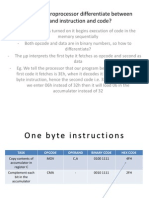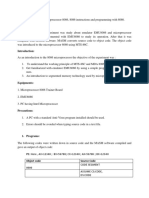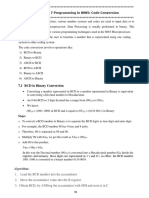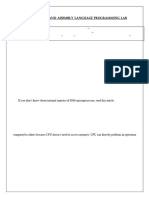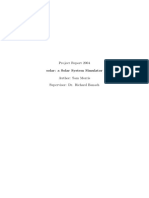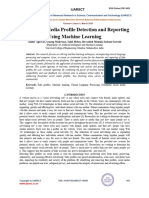Instruction Templates of Microprocessor 8086
Uploaded by
Tafzeel MohammadInstruction Templates of Microprocessor 8086
Uploaded by
Tafzeel Mohammad8086 Instruction Template Need for Instruction Template 8085 has 246 opcodes.
The opcodes can be printed on an A4 size paper. 8086 has about 13000 opcodes. A book of about 60 pages is needed for printing the opcodes. Concept of Template In 8085, MOV r1, r2 (ex. MOV A, B) has the following template. 0 1 3-bit r1 code Register B C D E H L M A MOV A, 01 11 1 7 B is 000 = 78H 8 3-bit r2 code
3-bit Register code 000 001 010 011 100 101 110 111 Ex. 1: Code for
Ex.2: Code for
MOV M, D is 01 11 0 010 = 72H 7 2
Using the template for MOV r1, r2 we can generate opcodes of 26 = 64 opcodes. 8086 Template for data transfer between REG and R/M 1 0 0 0 1 0 D W MOD 2 bits REG 3 bits R/M 3 bits
REG = A register of 8086 (8-bit or 16-bits) (except Segment registers, IP, and Flags registers) Thus REG = AL/ BL/ CL/ DL/ AH/ BH/ CH/ DH/ AX/ BX/ CX/ DX/ SI/ DI/ BP/ SP R/ M = Register (as defined above) or Memory contents (8-bits or 16-bits) W = 1 means Word operation W = 0 means Byte operation
D = 1 means REG is Destination register D = 0 means REG is source register MOD = 00 means R/M specifies Memory with no displacement MOD = 01 means R/M specifies Memory with 8-bit displacement MOD = 10 means R/M specifies Memory with 16-bit displacement MOD = 11 means R/M specifies a Register 3-bit Register code 000 001 010 011 100 101 110 111 Register name When W = 1 When W = 0 AX AL CX CL DX DL BX BL SP AH BP CH SI DH DI BH ALl Children Drink Bournvita (AL, CL, DL, BL) SPecial Beverages SIamese DrInk (SP, BP, SI, DI)
Aid to remember:
Case of MOD = 11 Example: Code for MOV AX, BX treated as Move from BX to destination register AX D 1 W 1 Word operation B MOD 11 REG 00 0 AX is destination C R/M 011 BX 3
1 0 0 0
= 8B C3H
Example: Alternative code for MOV AX, BX treating it as Move from source register BX to register AX D 0 0 W 1 Word operation 9 MOD 11 REG 01 1 BX is source 8 R/M 000 AX
1 0 0 0
= 89 D8H
There are 2 possible opcodes for MOV AX, BX as we can choose either AX or BX as REG.
Example: Code for MOV AL, BH treated as Move from BL to destination register AL D 0 1 W 0 Byte operation A MOD 11 REG 00 0 AL is destination C R/M 111 BH 7
1 0 0 0
= 8A C7H
Example: Alternative code for MOV AL, BH treating it as Move from source register BH to register AL D 0 0 W 0 Byte operation 8 MOD 11 REG 11 1 BH is source R/M 000 AL 8
1 0 0 0
= 88 F8H
There are 2 possible opcodes for MOV AL, BH as we can choose either AL or BH as REG. Case of MOD = 00, 01 or 10 R/M MOD = 00 No Displacement [SI+BX] [DI+BX] [SI+BP] [DI+BP] [SI] [DI] [BP] Direct Addressing [BX] MOD = 01 8-bit signed displacement d8 [SI+BX+d8] [DI+BX+d8] [SI+BP+d8] [DI+BP+d8] [SI+d8] [DI+d8] [BP+d8] [BX+d8] MOD = 10 16-bit signed displacement d16 [SI+BX+d16] [DI+BX+d16] [SI+BP+d16] [DI+BP+d16] [SI+d16] [DI+d16] [BP+d16] [BX+d16]
000 001 010 011 100 101 110 111
The table shows 24 memory addressing modes i.e. 24 different ways of accessing data stored in memory. Aid to remember: SubInspector DIxit is a BoXer ( [SI+BX] and [DI]+[BX] ) SubInspector DIxit knows to control BP ( [SI+BP] and [DI]+[BP] ) He says SImple DIet DIRECTs a BoXer' ( [SI], [DI], Direct addressing, [BX] )
Ex: Code for MOV CL, [SI] D 1 W 0 Byte operation A MOD REG R/M 00 00 1 100 No CL is [SI] Disp. destination 0 C
1 0 0 0
= 8A 0CH
Note that there is a unique opcode for MOV CL, [SI] as CL only can be REG. Ex: Code for MOV 46H[BP], DX D 1 0 0 0 1 0 0 W 1 Word operation 9 MOD REG R/M d8 01 01 0 110 46H 8-bit DX is [BP+d8] Disp. source 5 6
= 89 56 46H
Note that there is a unique opcode for MOV 46H[BP], DX as DX only can be REG. Ex: Code for MOV 0F246H[BP], DX D 0 0 W 1 Word operation 9 MOD 10 16-bit Disp. 9 REG 01 0 DX is source R/M 110 [BP+d16] 6 d16 F2 46H
= 89 96 F2 46H Stored as 89 96 46 F2H in Little Endian
Note that there is a unique opcode for MOV 0F246H[BP], DX as DX only can be REG.
Ex: Code for MOV [BP], DX D 0 W 1 Word operation 9 MOD REG R/M d8 01 01 0 110 00H 8-bit DX is [BP+d8] Disp. source 5 6
1 0 0 0 1 0
= 89 56 00H
Note that MOV [BP], DX is treated as MOV 00H[BP], DX before coding.
Ex: Code for MOV BX, DS:1234H D 1 0 0 0 1 0 1 W 1 Word operation 8 B MOD 00 REG 01 1 R/M 110 Direct addr. E Direct addr 12 34H
= 8B 1E 12 34H Stored as 8B 1E 34 12H In Little Endian
No BX is Disp. Dest. 1
Note that when MOD = 00 and R/M = 110, it represents Direct Addressing.
You might also like
- Converting assembly language to machine language (1)No ratings yetConverting assembly language to machine language (1)6 pages
- Ex: Write An ALP To Find The Sum of The Following Series: Sum 1 + 2 + 3 + 4 + 5 + 6 AnsNo ratings yetEx: Write An ALP To Find The Sum of The Following Series: Sum 1 + 2 + 3 + 4 + 5 + 6 Ans8 pages
- MPMC Ii-Unit: Instruction Formats of 8086No ratings yetMPMC Ii-Unit: Instruction Formats of 808612 pages
- Unit Ii Addressing Modes, Instruction Set and Programming of 8086No ratings yetUnit Ii Addressing Modes, Instruction Set and Programming of 808625 pages
- Microprocessor and Interfacing Notes Lab ReportsNo ratings yetMicroprocessor and Interfacing Notes Lab Reports64 pages
- Byte 7 6 5 4 3 2 1 0 1 Opcode D W 2 Reg R/M 3 (Optional) 4 (Optional) 5 (Optional) 6 (Optional)No ratings yetByte 7 6 5 4 3 2 1 0 1 Opcode D W 2 Reg R/M 3 (Optional) 4 (Optional) 5 (Optional) 6 (Optional)8 pages
- 8086 Instruction Set PPT 141126060207 Conversion Gate01No ratings yet8086 Instruction Set PPT 141126060207 Conversion Gate0191 pages
- AH AL CH CL DH DL SP BP SI DI SS ES CS: BH BLNo ratings yetAH AL CH CL DH DL SP BP SI DI SS ES CS: BH BL5 pages
- 80x86 - Instruction Set: Addressing ModesNo ratings yet80x86 - Instruction Set: Addressing Modes67 pages
- 8086 Microprocessor: 1 Ec - Vi - Ch1 - Mp2 - D R Mehta 9820727071No ratings yet8086 Microprocessor: 1 Ec - Vi - Ch1 - Mp2 - D R Mehta 982072707115 pages
- How Does Microprocessor Differentiate Between Data and Instruction100% (1)How Does Microprocessor Differentiate Between Data and Instruction60 pages
- Digital Logic and Microprocessor Lab Assessment 3 ALP 18MIS0079 Sriram.GNo ratings yetDigital Logic and Microprocessor Lab Assessment 3 ALP 18MIS0079 Sriram.G9 pages
- The Control Flags Can Be Set/reset by The ProgrammerNo ratings yetThe Control Flags Can Be Set/reset by The Programmer8 pages
- Final Microprocessor and Assembly Language Programming LabNo ratings yetFinal Microprocessor and Assembly Language Programming Lab53 pages
- Practical Reverse Engineering: x86, x64, ARM, Windows Kernel, Reversing Tools, and ObfuscationFrom EverandPractical Reverse Engineering: x86, x64, ARM, Windows Kernel, Reversing Tools, and ObfuscationNo ratings yet
- Exploring BeagleBone: Tools and Techniques for Building with Embedded LinuxFrom EverandExploring BeagleBone: Tools and Techniques for Building with Embedded Linux4/5 (2)
- CS602 Finalterm Solved MCQs With References by Moaaz100% (1)CS602 Finalterm Solved MCQs With References by Moaaz40 pages
- Vikingbags Odin Brown Large Saddlebags Hard Mount Instructions Parts List Tools Needed Step 1No ratings yetVikingbags Odin Brown Large Saddlebags Hard Mount Instructions Parts List Tools Needed Step 12 pages
- Project Report 2004 Solar: A Solar System Simulator Author: Sam Morris Supervisor: Dr. Richard BanachNo ratings yetProject Report 2004 Solar: A Solar System Simulator Author: Sam Morris Supervisor: Dr. Richard Banach56 pages
- Fake Social Media Profile Detection and ReportingNo ratings yetFake Social Media Profile Detection and Reporting6 pages
- Quick Guide VIO 200 S: Necessary Operating StepsNo ratings yetQuick Guide VIO 200 S: Necessary Operating Steps2 pages
- Spare Parts Catalog: 4 WG 200 (555/5) Material Number: 4644.024.173 Current Date: 12.07.2018100% (1)Spare Parts Catalog: 4 WG 200 (555/5) Material Number: 4644.024.173 Current Date: 12.07.201883 pages
- Submitted Proposal-DfT-QR To Connected Places Catapult Community PlatformNo ratings yetSubmitted Proposal-DfT-QR To Connected Places Catapult Community Platform27 pages
- An Introduction To The AWS Command Line Tool - LinuxNo ratings yetAn Introduction To The AWS Command Line Tool - Linux5 pages
- Converting assembly language to machine language (1)Converting assembly language to machine language (1)
- Ex: Write An ALP To Find The Sum of The Following Series: Sum 1 + 2 + 3 + 4 + 5 + 6 AnsEx: Write An ALP To Find The Sum of The Following Series: Sum 1 + 2 + 3 + 4 + 5 + 6 Ans
- Unit Ii Addressing Modes, Instruction Set and Programming of 8086Unit Ii Addressing Modes, Instruction Set and Programming of 8086
- Byte 7 6 5 4 3 2 1 0 1 Opcode D W 2 Reg R/M 3 (Optional) 4 (Optional) 5 (Optional) 6 (Optional)Byte 7 6 5 4 3 2 1 0 1 Opcode D W 2 Reg R/M 3 (Optional) 4 (Optional) 5 (Optional) 6 (Optional)
- 8086 Instruction Set PPT 141126060207 Conversion Gate018086 Instruction Set PPT 141126060207 Conversion Gate01
- 8086 Microprocessor: 1 Ec - Vi - Ch1 - Mp2 - D R Mehta 98207270718086 Microprocessor: 1 Ec - Vi - Ch1 - Mp2 - D R Mehta 9820727071
- How Does Microprocessor Differentiate Between Data and InstructionHow Does Microprocessor Differentiate Between Data and Instruction
- Digital Logic and Microprocessor Lab Assessment 3 ALP 18MIS0079 Sriram.GDigital Logic and Microprocessor Lab Assessment 3 ALP 18MIS0079 Sriram.G
- The Control Flags Can Be Set/reset by The ProgrammerThe Control Flags Can Be Set/reset by The Programmer
- Final Microprocessor and Assembly Language Programming LabFinal Microprocessor and Assembly Language Programming Lab
- Practical Reverse Engineering: x86, x64, ARM, Windows Kernel, Reversing Tools, and ObfuscationFrom EverandPractical Reverse Engineering: x86, x64, ARM, Windows Kernel, Reversing Tools, and Obfuscation
- Exploring BeagleBone: Tools and Techniques for Building with Embedded LinuxFrom EverandExploring BeagleBone: Tools and Techniques for Building with Embedded Linux
- Blowfish Cipher Tutorials - Herong's Tutorial ExamplesFrom EverandBlowfish Cipher Tutorials - Herong's Tutorial Examples
- CS602 Finalterm Solved MCQs With References by MoaazCS602 Finalterm Solved MCQs With References by Moaaz
- Vikingbags Odin Brown Large Saddlebags Hard Mount Instructions Parts List Tools Needed Step 1Vikingbags Odin Brown Large Saddlebags Hard Mount Instructions Parts List Tools Needed Step 1
- Project Report 2004 Solar: A Solar System Simulator Author: Sam Morris Supervisor: Dr. Richard BanachProject Report 2004 Solar: A Solar System Simulator Author: Sam Morris Supervisor: Dr. Richard Banach
- Spare Parts Catalog: 4 WG 200 (555/5) Material Number: 4644.024.173 Current Date: 12.07.2018Spare Parts Catalog: 4 WG 200 (555/5) Material Number: 4644.024.173 Current Date: 12.07.2018
- Submitted Proposal-DfT-QR To Connected Places Catapult Community PlatformSubmitted Proposal-DfT-QR To Connected Places Catapult Community Platform
- An Introduction To The AWS Command Line Tool - LinuxAn Introduction To The AWS Command Line Tool - Linux






































